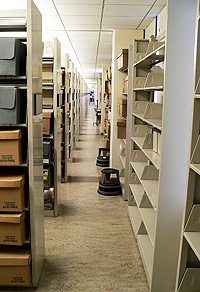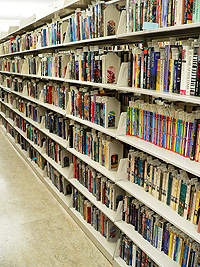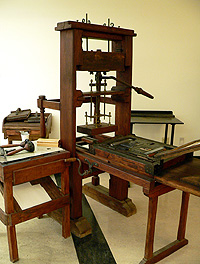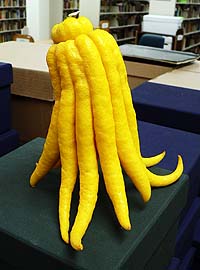January 3, 2007
The Special Collections, University of California Riverside -- Tour of stacks and a printshop -- The Reading Room rules.
The University of California Riverside Special Collections (SC) has a number of rare books from all areas of the arts and sciences, but the Eaton Collection of science fiction, fantasy and horror books are the focus of SP collection development. The collection was originated by Dr. J. Lloyd Eaton from Oakland, CA, physician and book collector. The original collection, donated to SC in 1969, consisted of about 7,500 hardback editions of science fiction, fantasy and horror from the late nineteenth century to 1955. During last four decades the collection was systematically enlarged with new additions so that today it consists of almost 100,000 items and is “the largest publicly-accessible collection of science fiction, fantasy, horror and utopian fiction in the world” (quote from the SP brochure). The SP also acquired a number of fanzines bringing their total number to almost 300,000. In addition to the books, the SC has a number of manuscript collections from SF and Fantasy writers. In principle, the SC collects anything related to SF and Fantasy – tapes, posters, memorabilia.
The SC is also a resource for the study of native American history and culture. The cornerstone of their holdings is the Rupert Costo Library of the American Indian, which is housed in its own library section with a reading room. The collection was formed by Rupert Costo (1906-1989) and Janette Dulce Henry Costo (1909-2001), Native American historians and civil rights activists, and includes 7,000 books, thousands of archival documents, and a collection of Indian artifacts, including baskets.
The Riverside campus of the University of California started as the citrus experimental station, so it is natural that the Special Collections Department at the University of California, Riverside (SC) has a large number of rare agricultural, botanical and natural science books and documents associated with the growing of citrus in the Riverside region.
As usual, there is a “survival book” with all the necessary numbers, contact and RULES. A lot of rules. I am not quite sure who needs to follow more rules - student-volunteers that work at the reception desk or patrons using materials.
The use of the SC material is open to all registered users of the library upon presenting proper picture ID and filling in a registration form. All backpacks, purses, bags, brief cases and other containers must be deposited in lockers provided at the reading room. This rule applies also to all UCR students (and SLIS interns) working at the SC. There are no fees for use of the reading room or accessing the collections. For each item, a patron must fill out a call slip. Patrons will be given up to two books at a time, or one folder at a time if they consult a manuscript collection. There should be somebody – student or staff - at the reception at all times.
Besides books, archives and Indian artifacts, the SC have a large collection of printing presses, type, printshop tools and furniture. Their most prized presses – English Common Wooden Press, Columbian Press and Columbian press manufactured by A. Seggie, Edinburgh – stand at prominent position in reading room. By the terms of the donation ALL presses (including English Wooden Press) should be kept in operational order and students attending printing classes should be able to use any they wish. The conference room behind the presses was converted to a printshop. The public is usually not allowed in the print shop – only SC staff and students attending classes. As I know how to set type and operate a small electric press, if it need arises, during my internship I will help students registered for the printing class in their printing or bookbinding projects.
January 5, 2007
Monitoring of environmental conditions in the main stack room: documenting temperature variations -- A research project on temperature and humidity (TH) dataloggers and environmental monitoring equipment -- A visual diary of the practicum -- Buddha's Hand.
At this moment, the SC does not have any comprehensive system of monitoring environmental conditions in the main stack room. The SC is located on the 4th floor of the Rivera Library building and they have continuous dispute with technical services over temperature oscillations in the SC rooms, so they would like to set up an air-conditioning system separate from the rest of the building. For the beginning, they would like to set up an efficient environmental monitoring system. My assignment is to research data collecting devices appropriate for the SP needs and write an analysis of equipment available on the market, and present their pros and cons. Basic guidelines for the research were following:
- Dataloggers that capture both, temperature and humidity(TH) data
- Measuring temperature of over 100F;
- Price tag for the system under $1,000;
- System that is designated for long term monitoring;
- To find out how many dataloggers would be the optimal for adequate monitoring of the entire main stack room;
- Explore pros and cons of USB vs. wireless data download.
My internship mentor, Sheryl Davis, suggested starting the research with a list of vendors of environmental monitoring equipment from the Conservation OnLine web site. Also, I was assigned a laptop computer with wireless internet connection, for use while on practicum. The written report should be submitted by January 12, 2007.
I asked for permission to take photographs of various things, processes and events during my internship, like some kind of visual diary. I was given the permission and, as long as I properly credit pictures to the UCR and SC, I also had a permission to publish them on the photosharing web site Flickr.
It is not only books one can encounter in the Special Collections. This odd looking citrus was brought by Heidi, the cataloger, who have a tree of this citrus variety growing in her garden. While preparing the Citrus Experiment Centennial Exhibition, Heidi also found images of the Buddha's Hand Citrus in one of books of the agricultural section of the Special Collections, showing that this is quite an old variety of citrus.
Total: 5 hours
Links:
:: UCR Special Collections home page
:: The Eaton Collection home page
:: The Tuskeege Airmen Archive
View down the main room of Special Collections.
Colorful stacks of the Eaton Collection.
The Common Wooden Press, ca. 1720s.
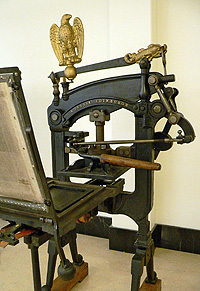
Columbian press manufactured by A. Seggie, Edinburgh.
Total: 13 hours
Links:
:: UCR Special Collections on Flickr
:: UCR Citrus Variety Collection
:: Citrus Experiment Centennial ...
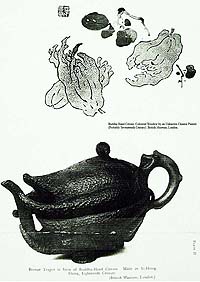
Images of Buddha's Hand Citrus from a book. Top caption: Buddha-Hand Citrus. Coloured Woodcut by and unknown Chinese painter (probably 17th century). British Museum, London. Bottom caption: Bronze Teapot in form of Buddha-Hand Citrus. Made in Yi-Hsing, China, 18th century. British Museum, London.
Text, design, photographs and
digital imaging by Vlasta Radan.
Last update May 25, 2007.
